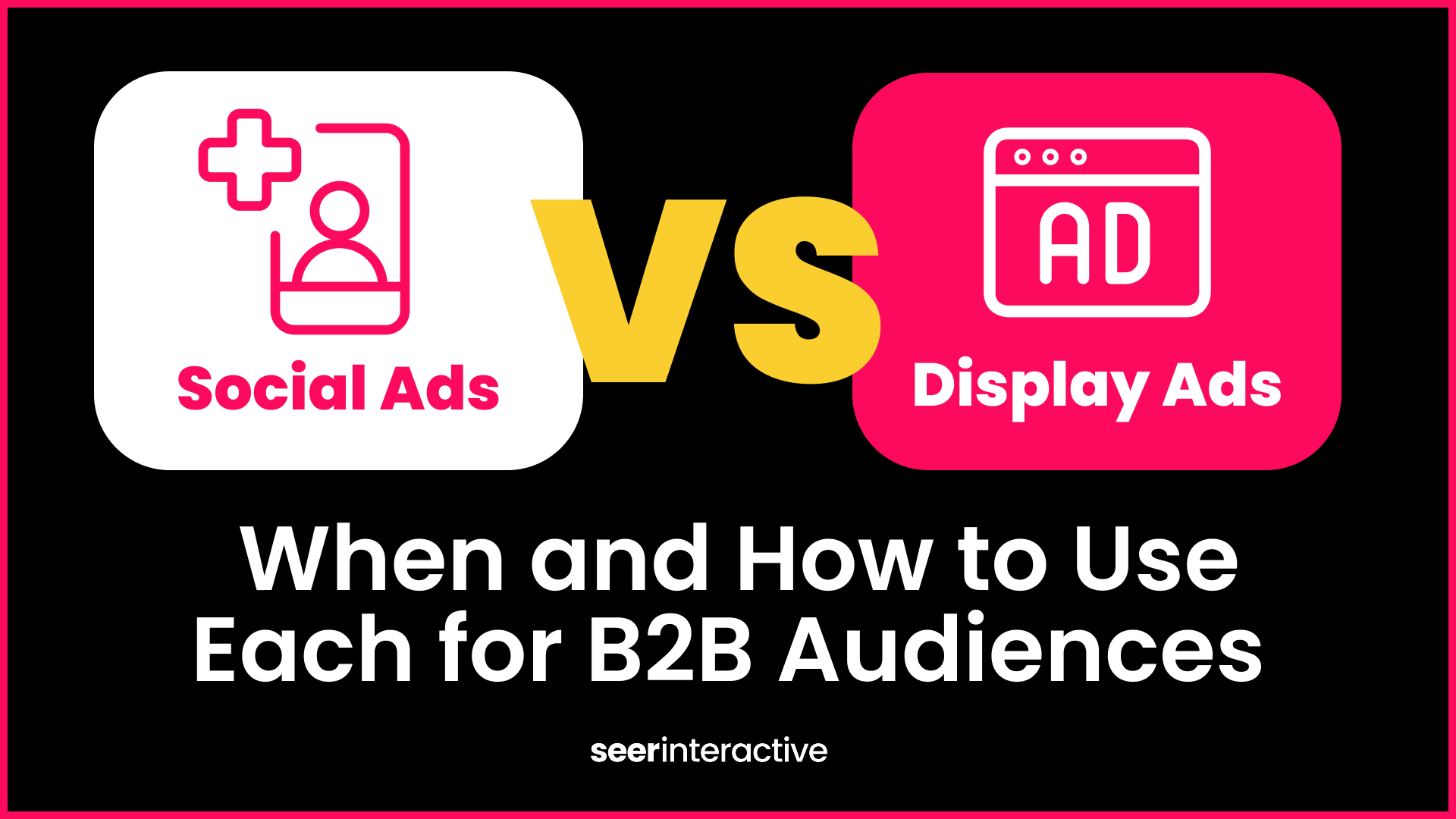Google ad campaigns are constantly evolving and it can be difficult to identify which campaign type will help you not only hit your paid media goals but also hit your business goals.
Whether you’re aiming for paid media wins or big-picture business growth, this blog is your guide to mastering Performance Max (PMAX) and Demand Gen—complete with clear, actionable use cases tailored to your needs.
Jump to a section below:
- What's the Difference Between PMAX and Demand Gen?
- When Does it Make Sense to Use Performance Max?
- When Does it Make Sense to Use Demand Gen?
- What Campaign Type You Should Use
- Google Ads Campaign Types in 2025
What's the Difference Between PMAX and Demand Gen?
Before we can get into when it makes more sense to use either Performance Max or Demand Gen, let’s clarify the key differences between these campaign types and where they overlap.
In the diagram below, you will see the main differences between each campaign type:
At a glance, the main differences are placements offered and targeting options:
- Demand Gen provides more control over targeting, ad placements, and reporting insights.
- PMAX relies heavily on AI, giving Google more control over who sees your ads and when/where they’re served.
PMAX ads are also now eligible to appear in AI overviews, creating an opportunity to align strategies for enhanced visibility in these contexts.
Learn more about how AI overviews impact paid performance
When Does it Make Sense to Use Performance Max?
PMAX offers a broad, full funnel approach, where users are engaged at all funnel stages from awareness to conversion. This is due to the large variety of networks that ads are served on for PMAX.
Want a campaign that does a lot of the work for you? Performance Max is a great option:
- Feed the campaign creative, copy, and your audience signals
- PMAX takes it from there
This is a great option if you are struggling to scale your search campaigns and are looking for a campaign type that can act as a supplement to your search efforts.
Performance Max is also a great option if you are trying to expand your reach to different networks such as Display, Shopping, and Google Maps. This campaign type typically drives efficient CPLs but quality can sometimes be an issue. If you run PMAX make sure you are using UTMs to track lead quality in your CRM.
Targeting Capabilities of PMAX:
PMAX relies on automated audience optimization using audience signals to expand targeting based on performance.
Pro Tip: PMAX can feel restrictive due to limited targeting and reporting options.
Overcome this by:
- Submitting negative keyword lists to Google Support to avoid irrelevant searches (you cannot set negative keywords for PMAX in Google Ads at this time)
- Install Google Ad scripts that give you insight into a channel breakdown report and other performance insights that Google doesn't show you within their platform
Limitations and Workarounds in Reporting:
PMAX does not readily provide performance by placement, search term or channel, but offers insights into search themes and audience performance.
Marketers can address these gaps by:
- Using tools like Google Analytics
- Leveraging custom reporting solutions
- Using scripts to extract channel performance data
Other Limitations:
Performance Max doesn’t directly support negative keyword implementation at the campaign level, but advertisers can use:
- Account-level negative keywords (applied across all campaigns)
- Request forms to Google to add campaign-level exclusions
When Does it Make Sense to Use Demand Gen?
Demand Gen is a top and mid-funnel campaign type, where users are targeted at the awareness and interest stages in their purchasing journey. Despite being more top-to-mid funnel focused, Demand Gen is a great option if you are focused more on quality control rather than rapidly scaling your paid media efforts.
Targeting Capabilities of Demand Gen:
The biggest differentiating factor between the two campaign types is that Demand Gen does offer more audience targeting controls, rather than giving the reins over to Google's AI.
This allows advertisers to select specific audiences or opt out of optimized targeting entirely.
For example: When opted in to optimized targeting, your audiences effectively work as audience signals - the same as PMAX. If you opt-out, you target those audiences specifically. By default, advertisers are now opted in.
The drawback to Demand Gen: Your reach will be smaller than PMAX since ads are served on less networks
The plus to Demand Gen: You get more flexibility for manual audience targeting compared to PMAX
Limitations and workarounds in Reporting:
Demand Gen lacks granular transparency, particularly regarding performance across networks like Gmail, YouTube, and Discover, where only basic segmentation is available, however it now provides visibility into YouTube channel placements.
.png?width=1418&height=788&name=PMAX%20and%20Demand%20Gen%20have%20their%20differences%2c%20but%20both%20require%20clear%20conversion%20signals%20to%20succeed.%20(1).png)
So What Campaign Type Should I Use?
To sum things up simply:
Performance Max: The #1 priority is scaling campaigns quickly and efficiently to maximize reach and conversion volume across multiple Google inventory types.
Demand Gen: #1 Priority is targeting control and pushing users down the funnel to the conversion stage - lead quality and campaign control is a top priority since you have more ability to review targets/placements.
Both of these are newer campaign types: PMAX leans into automation more than Demand Gen. However, given their relative strengths in different funnel-stages, it makes sense to use them where most appropriate to your business goals.
PMAX and Demand Gen both require clear conversion signals to succeed. If those signals aren’t available, advertisers risk poor performance, making manual control less relevant.
Strategies to maximize ROI across PMAX and Demand Gen:
For limited budgets, choose one campaign type based on KPIs:
- Use PMAX for efficient lead generation and to quickly scale
- Use Demand Gen for brand awareness or targeting specific audiences, such as using lookalike audiences
PMAX can start with a lower budget compared to Demand Gen, making it a more accessible option for testing.
To evaluate performance, tests should ideally run for 4-6 weeks, though duration depends on budget and goals.
It’s important to note that both campaign types require quality conversion signals. Industries without conversion tracking (e.g., restrictive healthcare) should avoid testing these.

Google Ads Campaign Types in 2025
Looking ahead, here’s what’s new for Google Ads in 2025:
- Demand Gen is evolving: It now uses audience signals like PMAX, leaning into optimized targeting while still offering options for more control (for now)
- Video Action Campaigns are being replaced by Demand Gen, consolidating YouTube conversion-focused campaigns under one type
- PMAX now supports image ad uploads (banners): This beta feature allows select accounts to upload banners
- Brand Guidelines Influence: Some advertisers are now eligible to upload brand guidelines to their PMax campaigns, which Google may use to align campaign visuals—details are still emerging
Final Thoughts on Google Ads Campaigns
Choosing between Performance Max and Demand Gen depends on your business goals, budget, and campaign priorities. By understanding their strengths, limitations, and use cases, you can craft strategies that maximize ROI and drive meaningful results.
Whether you’re looking to scale with automation or fine-tune targeting for high-quality leads, these campaign types offer unique opportunities to grow your paid media efforts.
Subscribe to our newsletter for the latest insights, trends, and actionable strategies in Google Ads, SEO, and more.


.png?width=640&height=356&name=Google%20Performance%20Max%20vs.%20Demand%20Gen%20-%20Whats%20the%20Difference%20Graphic%20(1).png)

